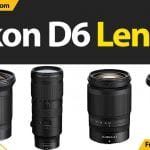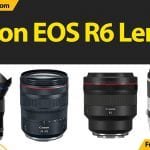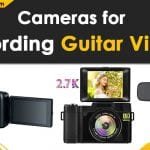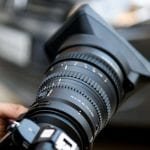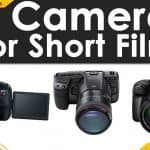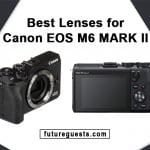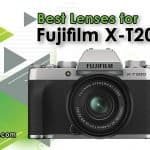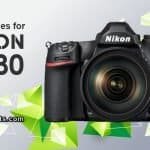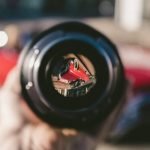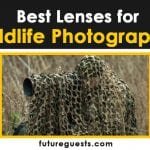It can oftentimes be overwhelming for photographers and videographers searching the market for Fujifilm X-T4 compatible lenses. Many questions flood your brain.
What are the best lenses for Fujifilm X-T4?
If you already have the new mirrorless digital Fujifilm X-T4 camera, you know it’s a magnificent new piece of technology. It can help you to create stunning art works.
But you also know that choosing the right lens, or lenses, is going to amplify the quality of your works.
Having the right lens is going to propel your work to the next level. Of course, you want to get to that next level.
So, in this article, I’m going to review the 10 best prime and zoom lenses that you could pair with this great new mirrorless camera.
I’ll go over the tech details and pros and cons, and finally provide an actionable Buyers Guide including a relevant, unique FAQ section to help you to pick out your best lenses for Fujifilm X-T4.
Editors' Picks
Best Overall Prime Lens
Fujifilm XF 56mm f/1.2 R APD
This is a great 56mm telephoto prime lens with an extremely bright aperture of f/1.2, which works great especially for shooting far subjects, portraiture and indoor sports.
It incorporates an apodization filter (APD) to create an incredible out-of-focus quality. So, you can achieve sharp images and extremely blurred backgrounds with some tasty bokeh!
It possesses 11 Elements in 8 Groups while having Fujifilm’s quite common Super EBC Coating applied on them. So, varying types of aberrations, ghosting and lens flare will be kept at bay!
An overall three-dimensional quality would be easier to produce that imaginable with this artistic bokeh-buddy!
Best Overall Zoom Lens
Fujifilm XF 100-400mm f/4.5-5.6 R LM OIS WR
A great super-telephoto zoom lens allowing you to zoom deeper than any of my suggested lenses here with the largest zoom range.
It is here just for supreme quality if you can afford it!
Being weather resistant, you can take this lens anywhere. Shoot wildlife from afar, shoot any breathtaking views you find when sightseeing, and worry not about cold or inclement weather conditions!
Not only great for bokeh but also it incredibly has 21 Elements in 14 Groups to ensure supreme color quality in your shots. Forget about aberrations, lens flare and ghosting then.
Just remember that it might not be the best fit only when dealing with some low-light situations.
Best Budget Prime Lens
Fujifilm XF 23mm f/2 R WR
A budget but weather-resistant prime lens with a nice f/2 aperture, which is great for anyone looking for some casual, general photography, indoor or outdoor, rainy, sunny, cold or hot.
It also has 10 Elements in 6 Groups covered in Super EBC Coating to prevent spherical aberrations and distortion.
And the rounded nine-blade diaphragm will be a great asset in capturing excellent bokeh.
This standard-length prime lens is another great travel-buddy, compact, and light.
Best Budget Zoom Lens
Fujifilm XF 55-200mm f/3.5-4.8 R LM OIS
A great budget telephoto zoom lens with a great zoom range.
This is a nice choice for capturing sports, and beautiful sceneries from afar thanks to its 4.5 stop-effective optical image stabilization system and a quiet autofocus system.
It has 14 Elements in 10 Groups covered with Fujifilm Super EBC Coating to fight aberrations, lens flare and ghosting.
A rounded seven-blade diaphragm is a nice plus if you occasionally want to capture some nice bokeh in your shots.
However, it doesn’t have weather-sealing, so use this for some beautiful outdoor shots as long as the weather is nice and consistent.
Best Value Prime Lens
Fujifilm XF 18mm f/2 R
An affordable wide-angle prime lens with a bright f/2 aperture and autofocus system, great for shooting landscapes, architecture and crowded situations especially in low-light situations!
Being light and compact, it’s especially nice for street photography… an incredible little travel pal!
with 8 Elements in 7 Groups covered with Super EBC coating, it can produce some high-quality sharp images by suppressing spherical aberrations, distortion, ghosting and lens flare.
It also works great for creating beautiful bokeh thanks to its rounded seven-blade diaphragm.
Best Value Zoom Lens
Fujifilm XF 16-55mm f/2.8 R LM WR
A fairly wide-angle, weather-resistant zoom lens with a flexible zoom range with a brightest aperture among the zoom lenses suggested in this article.
Aberrations are of no concern while accurate colors and great sharpness are guaranteed due to its 17 Elements in 12 Groups, including three aspherical elements and three extra-low dispersion elements.
Lens flare and ghosting are effectively prevented, and a rounded nine-blade diaphragm is in place to create some stellar bokeh.
Best choice for value among the zoom lenses!
The new mirrorless Fujifilm X-T4; is it even short of perfection?
It delivers the fastest autofocus among APS-C mirrorless cameras at 0.02 seconds. Extravagance such as that is probably why you want this camera.
And you also want to aid this camera as best as you can so it can perform to its best ability.
Enter: This Article.
Let’s figure out the best lenses for Fujifilm X-T4.
Whether that means to you, the absolute overall best, the best at a value, the best for low-light situations, the best for shooting landscapes, etc.
We’re going to cover all the great uses of some of the best compatible prime and zoom lenses and get down to the bottom of it all.
Down to the bottom of what it truly means to you, to figure out what’s the best lens for Fujifilm X-T4.
There’s lots of fantastic choices. Let’s start reviewing them!
BTW, you might want to read our recent articles on the compatible best lenses for Fujifilm X-T200 and Fujifilm X-T30.
What are the Best Lenses for Fujifilm X-T4 in 2020?
Quick Answer:
Best Prime Lenses for Fujifilm X-T4
Best Zoom Lenses for Fujifilm X-T4
Comparison Table for the Best Prime Lenses for Fujifilm X-T4
| Camera Lens | View on amazon | Elements | Weight (g) | Coating / Weather Resistance | Diaphragm |
|---|---|---|---|---|---|
| Fujifilm XF 14mm f/2.8 R | 10 Elements in 7 Groups including 2 Aspherical & 3 Extra-low dispersion | 235 | Super EBC Coating / No | Rounded seven-blade | |
| Fujifilm XF 18mm f/2 R | 8 Elements in 7 Groups including 2 Aspherical & no Low Dispersion | 116 | Super EBC coating / No | Rounded seven-blade | |
| Fujifilm XF 23mm f/2 R WR | 10 Elements in 6 Groups including 2 Aspherical & no Low Dispersion | 180 | Super EBC Coating / Yes | Rounded nine-blade | |
| Fujifilm XF 56mm f/1.2 R | 11 Elements in 8 Groups including 1 Double-sided Aspherical & 2 Extra-Low Dispersion | 405 | Super EBC Coating / No | Rounded seven-blade | |
| Fujifilm XF 56mm f/1.2 R APD | 11 Elements in 8 Groups including 1 Double-sided Aspherical & 2 Extra-Low Dispersion | 405 | Super EBC Coating / No | Rounded seven-blade |
Comparison Table for the Best Zoom Lenses for Fujifilm X-T4
| Camera Lens | View on amazon | Elements | Weight (g) | Coating / Weather Resistance | Diaphragm |
|---|---|---|---|---|---|
| Fujifilm XF 10-24mm f/4 R OIS | 14 Elements in 10 Groups including 4 Aspherical & 3 Extra-Low Dispersion | 410 | Super EBC Coating / No | Rounded seven-blade | |
| Fujifilm XF 16-55mm f/2.8 R LM WR | 17 Elements in 12 Groups including 3 Aspherical & 3 Extra-Low Dispersion | 655 | HT-EBC and Nano-GI Coating / Yes | Rounded nine-blade | |
| Fujifilm XF 50-140mm f/2.8 R LM OIS WR | 23 Elements in 16 Groups including 0 Aspherical, 5 Extra-Low Dispersion & 1 Super ED | 995 | HT-EBC and Nano-GI Coating / Yes | Rounded seven-blade | |
| FUJIFILM XF 55-200mm f/3.5-4.8 R LM OIS | 14 Elements in 10 Groups including 1 Aspherical & 2 Extra-Low Dispersion | 580 | Super EBC Coating / No | Rounded seven-blade | |
| Fujifilm XF 100-400mm f/4.5 - 5.6 R LM OIS WR | 21 Elements in 14 Groups including 0 Aspherical, 5 Extra-Low Dispersion & 1 Super ED | 1,375 | HT-EBC Coating / Yes | Rounded nine-blade |
Best Prime Lenses for Fujifilm X-T4 in 2020
1. Fujifilm XF 14mm f/2.8 R
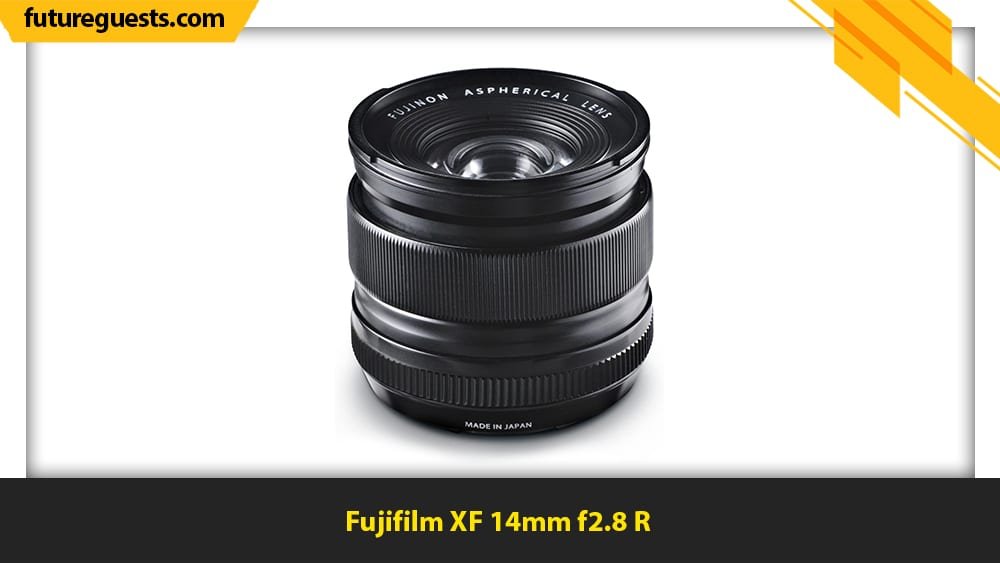
We’re going to start with a great wide-angle prime lens. The 14mm is the widest angle of the prime lenses suggested here.
Though, the f/2.8 aperture is the lowest aperture of the prime lenses, this aperture is still fast enough, and paired with the great focal length, take this lens out to shoot landscapes, architecture, crowded interiors, you name it!
This wide-angle prime lens has 10 Elements in 7 Groups. This includes two aspherical elements and three extra-low dispersion elements.
Of all the prime lenses, it has the highest number of low-dispersion elements, so it will block out chromatic aberrations or color fringing phenomenally.
If your idea of the best lenses for Fujifilm X-T4 includes the best color realization, then just look to this lens!
The Elements have been coated with the Super EBC Coating to suppress some lens flare and ghosting. And a rounded seven-blade diaphragm is nice for creating beautiful bokeh!
This autofocus lens has a Minimum Focus Distance of 18cm. And it weighs just 235 grams.
Now, it’s not the lightest of the prime lenses here, but it’s far from the heaviest. This weight keeps it quite portable.
And it costs about $899. Similar to how it ranks regarding its weight, it’s right in the middle. Not to the most expensive. Not the cheapest. Snugly fit right in the middle of all the prime lenses here.
Pros
- Wide-angle (widest of the prime lenses)
- Good number of elements; the greatest number of low-dispersion elements for excellent color quality
- Cost is decent for the quality
Cons
- Worst aperture among the prime lenses
- Not weather-resistant
- Produces good bokeh, but not the best
Expert Opinion:
2. Fujifilm XF 18mm f/2 R
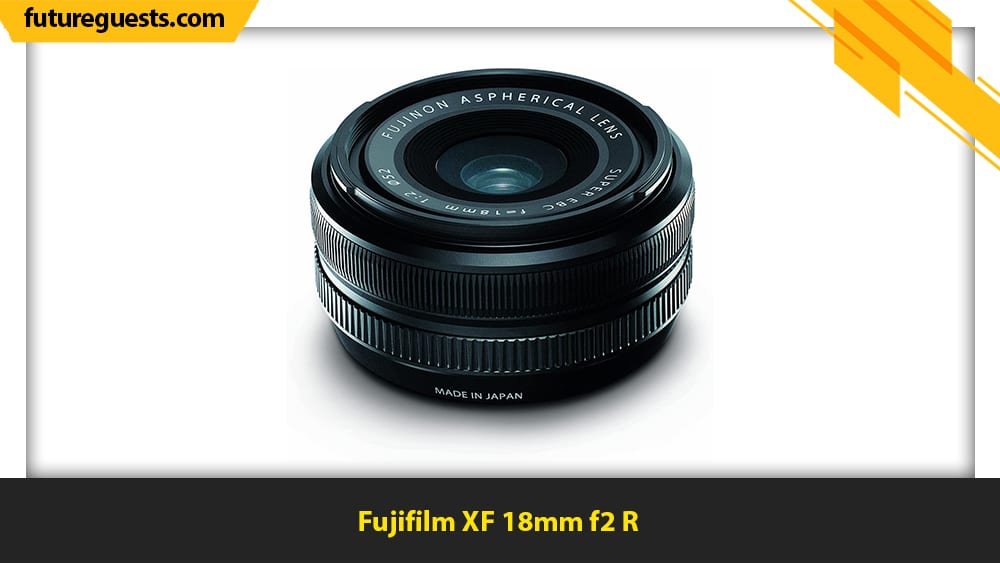
Now, we move up to the 18mm prime from Fujifilm. Still a wide-angle and great for landscapes and real estates and crowded situations, but not quite as wide as the last one.
However, this lens makes up for it by having a brighter f/2 aperture. So, if you want landscapes and may be dealing with low-light situations, this could be a better pick.
Additionally, its pancake-shape form, which measures less than 1.6 inches thick, with its weight of 116 grams, make this light and compact lens easy to bring with you anywhere.
Especially nice for street photography… an incredible little travel pal!
This lens has 8 Elements in 7 Groups, including two aspherical elements. It produces some sharp images as the aspherical elements will block out spherical aberrations and distortion.
The lack of low-dispersion elements might be of concern to you if vivid colors is what you really want. But if you’re a black and white type of shooter, this might not be as much of a worry to you.
A Super EBC coating is applied to all the elements to prevent ghosting and lens flare.
You’ll be happy to hear that it also has a rounded seven-blade diaphragm if you have a desire for beautiful bokeh.
Another autofocus lens with a Minimum Focus Distance of 18cm.
And a nice perk to this affordable lens, it only costs about $599.
Pros
- Among the two widest angled prime lenses with better aperture
- Lightest lens and very compact
- One of the cheapest lenses suggested
Cons
- Least number of elements; no low-dispersion elements
- Not weather-resistant
- Produces good bokeh, but not the best
Expert Opinion:
3. Fujifilm XF 23mm f/2 R WR
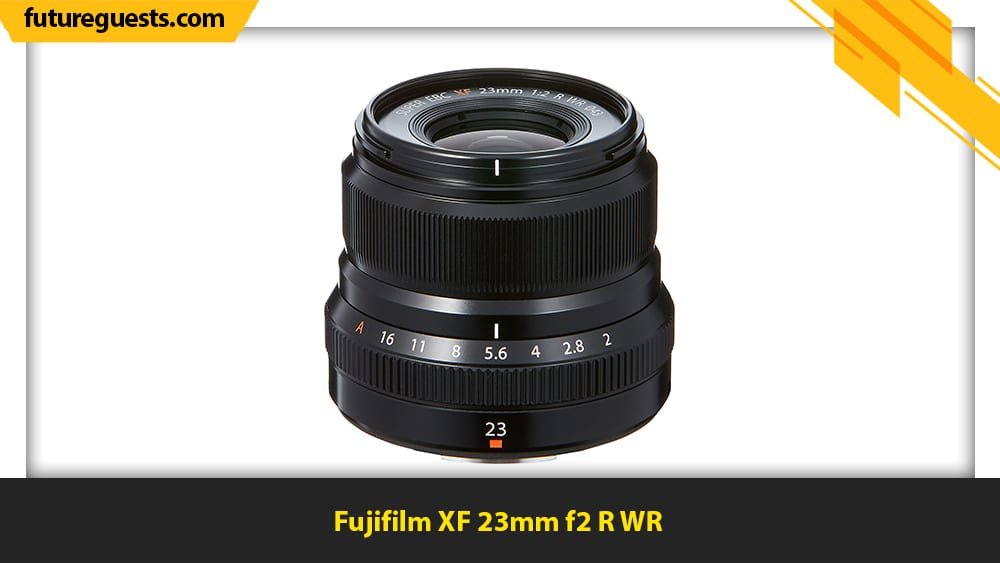
Here we’ve zoomed out to a slightly less wide-angle.
Bordering between the wide-angle and standard-length, this is a nice lens for those who aren’t “wide-angle-extremists.”
With a nice f/2 aperture, this is a great choice for anyone looking for a standard-length prime lens who is perhaps looking for some casual, non-specific, general photography.
The WR in the lens name means that it is weather-resistant, and it’s the only one of these prime lenses, which is weather-resistant.
You may consider this one as the best lens for Fujifilm X-T4 if you’re planning on taking it with you anywhere, regardless of the weather.
It can withstand temperatures as low as 14 degrees Fahrenheit and can handle inclement conditions, so don’t be afraid of any cold, wet weather.
Here, you’re working with 10 Elements in 6 Groups, including two aspherical elements to prevent spherical aberrations and distortion.
No low-dispersion elements though!
Just like the last lens, could be a downside if you love your vivid colors to be represented accurately. Perhaps not a big deal if you shoot B&W as if they never invented color.
The elements are covered with Super EBC Coating, a decent coating Fujifilm uses on its lenses.
And the rounded nine-blade diaphragm will be a great asset in capturing excellent bokeh.
This standard-length prime is another great travel-buddy, compact, and light, weighing only 180 grams.
All these nice features, and the cost is only about $449.
Pros
- Cheapest of all the prime lenses and one of the lighter ones
- Very nice for bokeh
- Weather-resistant
Cons
- No low-dispersion elements
- 23mm focal length is a nice standard-length but doesn’t excel in any particular wide-angle or telephoto situation
Expert Opinion:
4. Fujifilm XF 56mm f/1.2 R
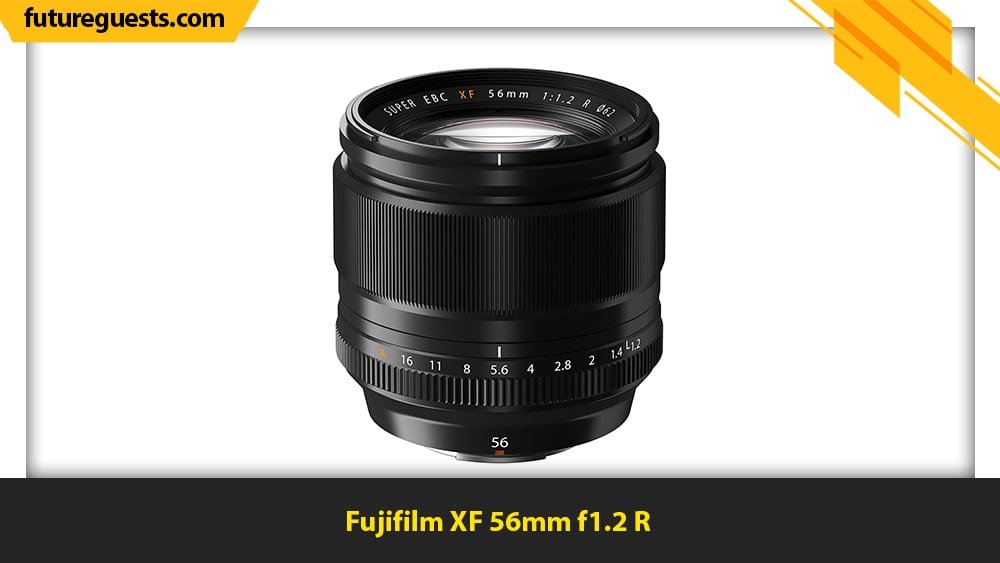
Here’s a nice telephoto lens, with the 56mm focal length.
Portraiture, subjects from afar, and indoor sports are all quite possible.
With an f/1.2 aperture which is extremely bright, it is tied for one of the brightest apertures here, so you’re not going to have any issues there.
Maybe this is your lens for interviewing or creating the next hit web series!
You’re working with 11 Elements in 8 Groups including one double-sided aspherical element and two extra-low dispersion elements.
So, aberrations will be kept at bay! This lens has plenty to combat varying types of aberrations.
And Fujifilm’s quite common Super EBC Coating is applied to these elements to prevent ghosting and lens flare.
And a rounded seven-blade diaphragm will be your friend in producing pleasing bokeh.
This lens weighs 405 grams which is definitely a heavier prime lens. And the cost is a hefty $999.
So, it’s not the easiest to carry around, and it’s the most expensive lens we’ve looked at so far, but don’t forget the aperture far exceeds the rest of the prime lenses we’ve looked at so far.
Pros
- Great telephoto range for a prime lens
- Tied for the best aperture among the prime lenses
- Great number of varied elements to block out varied types of aberrations
Cons
- Tied for the heaviest prime lens
- Not weather-resistant
- Fairly expensive
Expert Opinion:
5. Fujifilm XF 56mm f/1.2 R APD
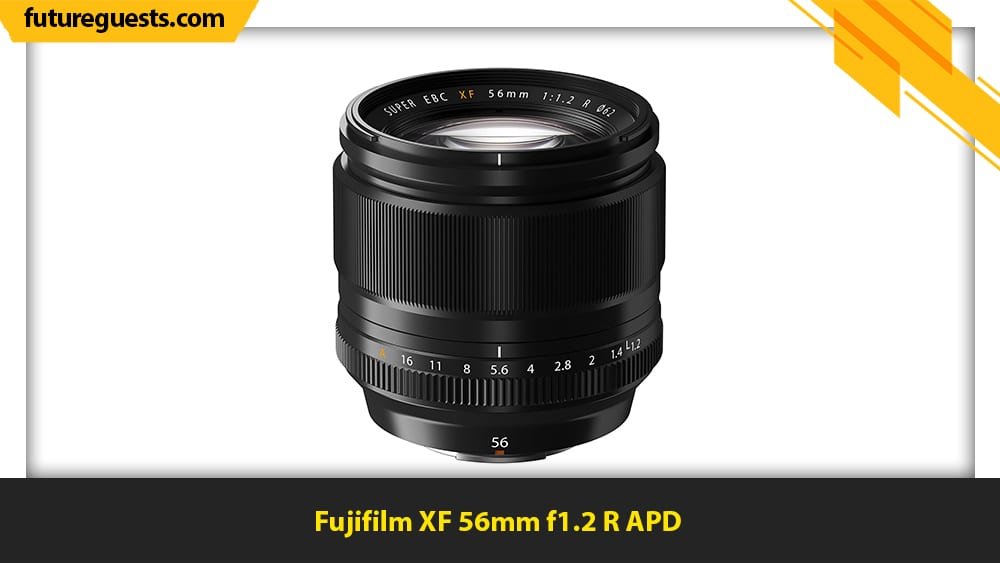
Now, I know some of you are looking at the name of this lens, and then checking back to the name of the previous one.
Yes, you are seeing almost double. The one difference in the name, is the APD at the end of the name.
Before we get to what the APD means, let’s briefly touch on the fact that the focal length of 56mm offers the same great telephoto range. And you get the same excellent f/1.2 aperture.
You still have 11 Elements in 8 Groups, which still includes the double-sided aspherical element and the two extra-low dispersion elements.
Still have Super EBC Coating and this lens also weighs 405 grams. So, it’s the same weight and has all the same specs and elements to keep your images as sharp and accurately colored as the previous lens.
The rounded seven-blade diaphragm is also present here, but bokeh-enthusiasts… pull up a chair.
The APD means this lens incorporates an apodization filter so that you can produce an incredible out-of-focus quality.
With this lens you can achieve sharp main subjects and extremely blurred backgrounds with some tasty bokeh!
An overall three-dimensional quality is easier to produce that imaginable with this artistic bokeh-buddy!
The apodization filter operates best at wider apertures, so a 3-stop ND filter is built into the lens in order to help control exposure.
This lens uses two separate sets of aperture values, one relates to the depth of field and the other refers to the actual f/stop number. The difference between these two numbers indicates the effectiveness of the filter.
So, if you’re looking for big bang with your bokeh, then this is the best lens for Fujifilm X-T4. The cost though is about $1,499.
Pros
- Great telephoto range for a prime and tied for best aperture among the prime lenses
- Great number of varied elements to block out varied types of aberrations
- Best lens for bokeh!
Cons
- Tied for the heaviest prime lens
- Not weather-resistant
- Most expensive prime lens
Expert Opinion:
Best Zoom Lenses for Fujifilm X-T4 in 2020
6. Fujifilm XF 10-24mm f/4 R OIS
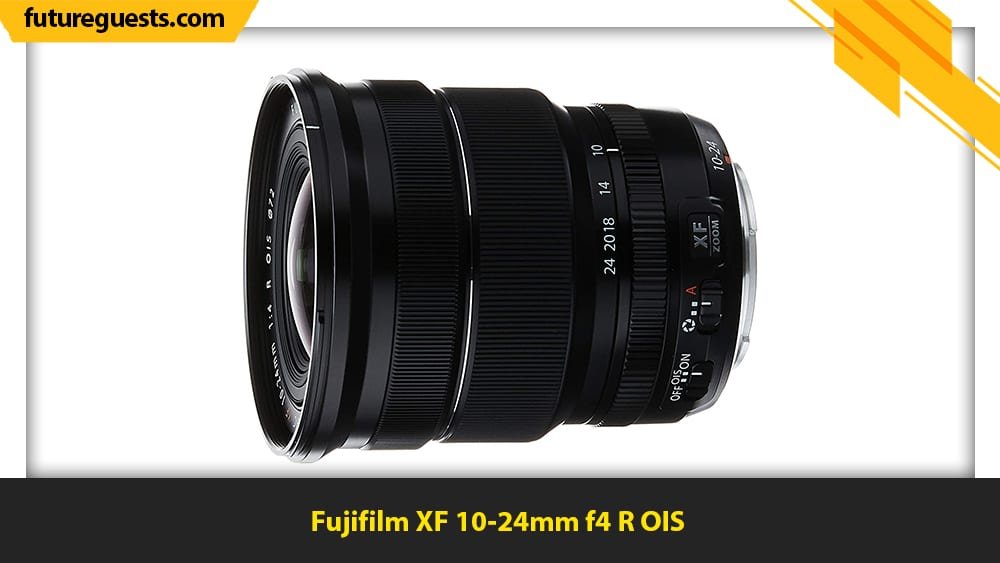
Taking a look at zoom lenses, here we have a focal length range of 10-24mm (15-36mm equivalent focal length).
This gives you the option of the lowest focal length at 10mm. This is affording you the widest angle of all the zoom lenses and prime lenses.
Additional plus, you are still afforded some flexibility… up to 24mm.
The ultimate lens for landscape and architecture or crowded streets.
And a consistent f/4 aperture is not bad. That finds itself to be the lowest of the zoom lenses that have a consistent aperture, but right smack dab in the middle when you look at all of them.
This lens has 14 Elements in 10 Groups. That includes a whopping four aspherical elements and three extra-low dispersion elements.
With all of that support, you’re not going to have to worry about aberrations at all. Sharpness and accurate colors will be all too easily achieved.
And the very common Super EBC Coating is applied to the elements to limit any ghosting or lens flare.
And a rounded seven-blade diaphragm will get you some decent bokeh.
The Optical Image Stabilization system is going to do wonders for you when trying to keep things still.
The Stepping Motor will help with your focusing needs quite nicely.
And the weight is 410 grams, making it the lightest zoom lens, a nice detail if you plan to carry your lens on long trips.
And the cost is only about $999, which is the second cheapest zoom lens here.
Pros
- Has the widest angle available of all the zoom lenses here. Also, it is the lightest zoom lens
- Greatest number of aspherical elements in order to keep sharpness and clarity
- Aperture is decent but notably, is consistent throughout the zoom range
Cons
- Zoom range is by far the lowest of all the zoom lenses
- Only has Super EBC Coating and is not weather-resistant
- Has a Stepping Motor as opposed to a Linear Motor
Expert Opinion:
7. Fujifilm XF 16-55mm f/2.8 R LM WR
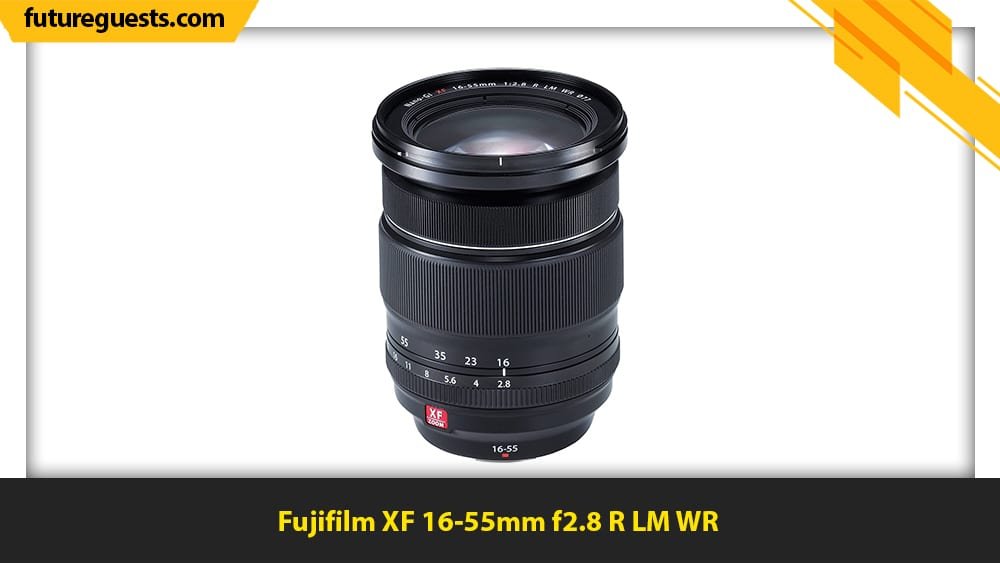
Now, we have a zoom lens that still gets you a nice, wide angle but gives you a bit more range than the last wide-angle zoom lens.
The 16-55mm doesn’t go quite as wide, but it’s more flexible.
And the f/2.8 aperture is a good deal brighter. It’s tied for the best aperture among these zoom lenses.
So, if you want a fairly wide-angle but aren’t set in your wide-angle ways, this could be the best lens for your Fujifilm X-T4.
You’ll love all the elements with this lens! 17 Elements in 12 Groups, including three aspherical elements and three extra-low dispersion elements.
Almost as much as the last lens, so aberrations are no problem, and vivid and accurate colors and great sharpness are going to be wonderfully common in your work.
A step up from the last lens, the elements here are coated with Nano-GI coating and an HT-EBC coating to give you even more accurate colors and stop lens flare and ghosting in its tracks.
And a rounded nine-blade diaphragm for some stellar bokeh is a plus.
One downside is the lack of Image Stabilization system, but the Twin Linear Motor is yet another step up.
And this wide-angle zoom lens is weather-resistant!
As is the case with Fujifilm’s weather-resistance, use it in inclement conditions and temperatures as low as 14 degrees Fahrenheit with no worries.
A good deal heavier, clocking in at 655 grams. And it’s more expensive… about $1,199.
Pros
- Affords you a fairly wide angle along with a better zoom range than the previous wide-angle zoom lens
- HT-EBC and Nano-GI Coating applied and being weather-resistant
- Tied for the best aperture among the zoom lenses and is a consistent aperture
- Good balance of elements and is great for bokeh
Cons
- Zoom range is still the second lowest of all the zoom lenses
- No image stabilization system
- Compared to other wide-angle zoom lens, it’s heavier and more expensive
Expert Opinion:
8. Fujifilm XF 50-140mm f/2.8 R LM OIS WR
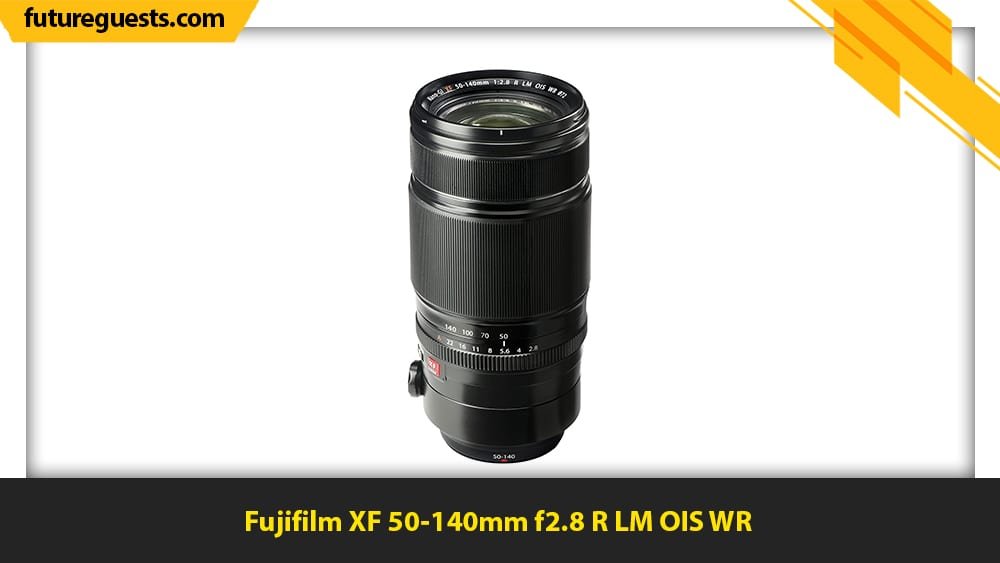
Here we have a larger range in the focal length; the 50-140mm ranges from standard-length to a decent telephoto.
This lens is also tied for the best aperture among the zoom lenses being reviewed here with a real fast f/2.8. And the consistency of the aperture range checks a nice box for you.
Speaking of checking some boxes, with this lens you got an Optical Image Stabilization system, like the first zoom lens.
You got weather-resistance, like the second zoom lens.
And you got a Triple Linear Motor autofocus system, a more robust motor than both of the other two zoom lenses.
So far, this one’s looking really nice! Right?
And hold on to your potatoes, we got 23 Elements in 16 Groups! Though it has no aspherical elements, it does include five extra-low dispersion elements and one Super ED element!
That’s going to give you some of the most accurate colors you could hope to shoot.
And along with the rounded seven-blade diaphragm, the lack of aspherical elements will actually assist you in producing some nice bokeh if you care for that.
This powerhouse of a lens has HT-EBC Coating along with a Nano-GI Coating in order to provide excellent protection against ghosting and lens flare.
With all these details to love, it’s a heavy lens, 995 grams. And you have to expect to shill a pretty penny for it, the cost being about $1,599.
Pros
- Greatest number of elements, tied for greatest number of low-dispersion elements for phenomenal color quality
- Have HT-EBC and Nano-GI Coating and is weather-resistant
- Tied for the best aperture among zoom lenses and is consistent throughout the zoom range
- Triple Linear Motor autofocus system
Cons
- No aspherical elements
- Only decent for bokeh
- Second most expensive and heaviest zoom lens here
Expert Opinion:
9. FUJIFILM XF 55-200mm f/3.5-4.8 R LM OIS
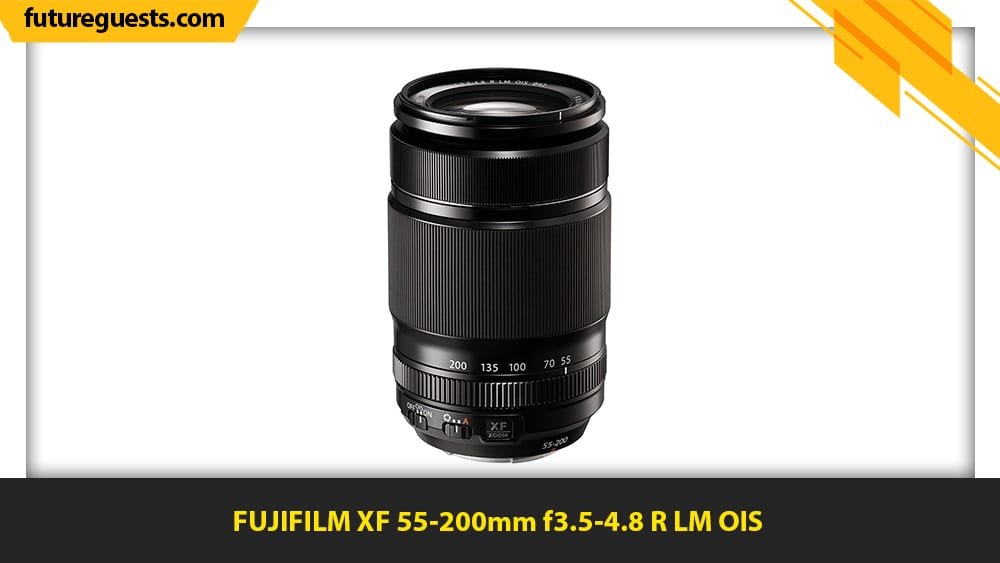
With this 55-200mm zoom lens, the focal length has just about the same starting point as the previous one but reaches much farther.
It has one of the most flexible zoom ranges, though it does come with the inconsistent f/3.5 – 4.8 aperture range. Lower than the others but still decent.
With a 4.5 stop-effective optical image stabilization system to limit camera shake and a Linear Motor for quick and quiet autofocus, paired along with the impressive zoom range, this is a great choice for capturing sports and beautiful sceneries from afar.
Don’t feel the need to be so close to your subjects with this lens, set up and let the shots come to you!
Keep in mind this lens doesn’t have weather-sealing, so use this for some beautiful outdoor shots as long as the weather is nice and consistent.
And you’ll be working with 14 Elements in 10 Groups. Having just one aspherical element and two extra-low dispersion elements, so it will limit it’s fair share of varied aberrations.
The base line for Fujifilm`s Super EBC Coating is applied to these elements to lend a hand preventing ghosting and lens flare.
A rounded seven-blade diaphragm is a nice plus if you occasionally decide you want to capture some nice bokeh in your shots. Though, this won’t be the lens you get if you’re a bokeh-enthusiast.
But it’s on the lighter side, weighing just 580 grams, so it’s fairly portable.
And you’ll love the cost of about $699. This is the cheapest zoom lens reviewed here.
This might be your best lens for Fujifilm X-T4 if you aren’t looking for every bell and whistle, and you are willing to compromise while still keeping some great details, and want to cut the cost on your purchase.
Pros
- Cheapest of all the zoom lenses here
- Second lightest zoom lens here
- Impressive zoom range, second largest of them all
Cons
- Lower number of overall elements
- Only has Super EBC Coating and is not weather-resistant
- Aperture is only okay and is inconsistent throughout the zoom range
Expert Opinion:
10. FUJIFILM XF 100-400mm f/4.5-5.6 R LM OIS WR
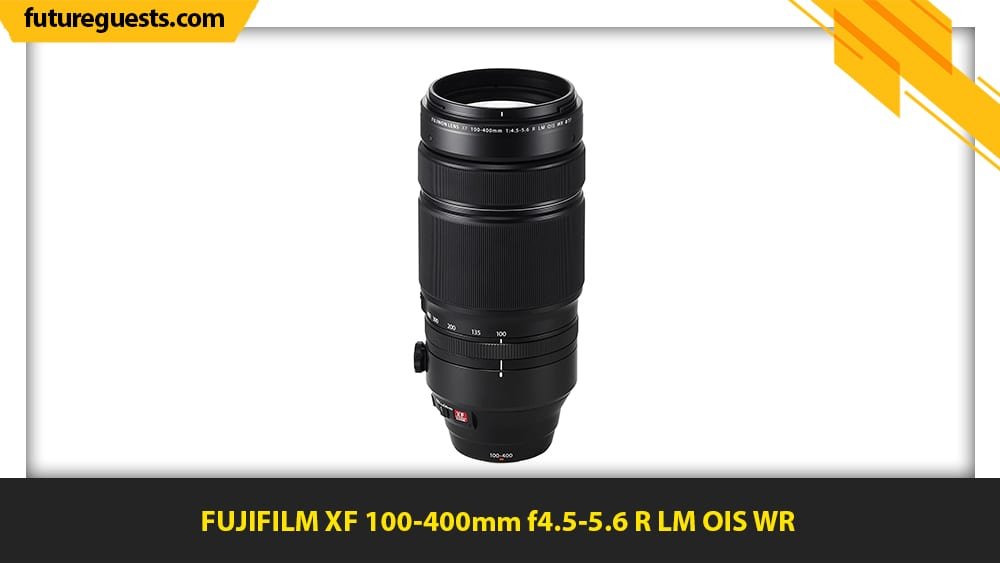
And here we go… when you talk about a zoom lens, you probably are thinking about the zoom, right?
This beautiful super-telephoto zoom lens does exactly what you want it to.
It has a deep 100-400mm focal length range, allowing you to zoom deeper than any others and gives you the largest range.
Immediate compromise you may notice, the aperture of f/4.5 – 5.6 is inconsistent and is the slowest of all the apertures.
Keep that in mind as this might not be the best fit if you’re dealing with low-light situations.
Though, for most other situations, this is a fantastic fit.
21 Elements in 14 Groups is incredible. Five extra-low dispersion elements and one Super ED element are available for supreme color quality in your shots.
And the HT-EBC Coating only adds to that sentiment while also combating lens flare and ghosting.
There aren’t any aspherical elements, so if distortion or spherical aberrations are a concern for you, that can be a downside.
But pairing the lack of aspherical elements along with the rounded nine-blade diaphragm is a recipe for some tasty bokeh.
A five stop-effective optical image stabilization system will limit any inkling of camera shake. Twin Linear AF motors is close to top of the line for autofocus performance.
Oh, and weather-resistance.
Basically, you can take this lens anywhere. Photograph wildlife from afar, shoot any breathtaking views you find in your travels, and worry not about cold or inclement weather conditions.
Though, it will perform anywhere you take it, keep in mind you got to carry it.
It’s the heaviest zoom lens by far, weighing 1,375 grams.
This super-telephoto zoom lens is also the most expensive, costing about $1,899. But if you want supreme quality, it’s worth it.
Pros
- Best zoom range of all the zoom lenses here; and Best telephoto range here
- Tied for greatest number of low-dispersion elements for phenomenal color quality and excellent for bokeh
- HT-EBC Coating and is weather-resistant
- Twin Linear autofocus motors
Cons
- Worst aperture of all the zoom lenses and is inconsistent throughout the zoom range
- No aspherical elements
- Heaviest of the zoom lenses
- Most expensive of the zoom lenses
Expert Opinion:
Best Lenses for Fujifilm X-T4 — Buyers Guide
As you can see, there’s a bevy of options in the lens department. For the Fujifilm X-T4 user, your biggest problem is just figuring out which lens best suits you.
When buying a camera some don’t have the clearest idea of what they’ll be using it for until after they’ve gotten it.
Some people know right away what they want it for. Sometimes in addition to either of those scenarios… one may develop a new interest.
That’s always a good thing to keep in mind, perhaps getting the right lens, but one that affords you some flexibility if you add onto your intended uses.
No matter the uses, you need to know the details of the lenses in order to pick out the best lenses for Fujifilm X-T4.
As we’ve already gone over all the details, it’s time to put them to good use.
So, let’s answer some frequently asked questions in order to cover the questions you might have and questions that maybe you didn’t think to ask.
That way we can pick out the best lenses for Fujifilm X-T4 in all general and specific cases.
What are the best lenses for Fujifilm X-T4 if I want fast aperture?
For prime lenses, it’s a tie between the Fujifilm XF 56mm f/1.2 R and the Fujifilm XF 56mm f/1.2 R APD.
The main differences between these two are that the former is $500 cheaper and the latter is a beautiful bokeh begetter.
For the zoom lenses, it’s another tie.
You should choose either the Fujifilm XF 16-55mm f/2.8 R LM WR if you also want a wide-angle to standard-length zoom or the Fujifilm XF 50-140mm f/2.8 R LM OIS WR if you are fancy about the standard-length to mid-telephoto range.
What are the best lenses for Fujifilm X-T4 if I want to shoot wide angles/landscapes?
For zoom lenses, I would definitely go with the Fujifilm XF 10-24mm f/4 R OIS. Wide-angle is what this lens is made for.
For prime lenses, I say 9 times out of 10, you will want the widest angle with the Fujifilm XF 14mm f/2.8 R.
This lens is fantastic for landscapes and other wide-angle shooting.
The 1 time out of 10, I may suggest to choose a different prime lens, is if you know you’ll be working in some low-light situations and don’t mind sacrificing a tad bit of your wide-angle capabilities.
Then, I’d say consider the almost as wide, and much brighter, Fujifilm XF 18mm f/2 R.
What are the best lenses for Fujifilm X-T4 if I want to use them for shooting outdoor sports/activities?
For prime lenses, I would say choose the Fujifilm XF 23mm f/2 R WR.
It’s a nice fast aperture, not the fastest, but it’s the only prime reviewed here that’s weather-resistant… good to have just in case.
If it’s a zoom lens you want, which may be the smarter choice with moving subjects, go with the Fujifilm XF 16-55mm f/2.8 R LM WR if you’re fairly close to the action.
If you’re a bit farther away, consider the Fujifilm XF 50-140mm f/2.8 R LM OIS WR.
Both have the fastest apertures of the zoom lenses and both are weather-resistant. They’ll both serve as your great outdoor companions.
What are the cheapest best lenses for Fujifilm X-T4?
The cheapest zoom lens is the FUJIFILM XF 55-200mm f/3.5-4.8 R LM OIS at about $699.
It also has the second largest zoom range which is nice!
And the cheapest prime lens, which is also the cheapest of them all, is the Fujifilm XF 23mm f/2 R WR at about $449.
Bonus: It’s weather-resistant too!
What are the best lenses for Fujifilm X-T4 if I want to produce fantastic bokeh?
The clear choice among the prime lenses, and among all these lenses, is the Fujifilm XF 56mm f/1.2 R APD. It was made for bokeh indeed.
If you absolutely feel you need to have a bokeh-making lens that also can zoom, then you have the FUJIFILM XF 100-400mm f/4.5-5.6 R LM OIS WR for large zoom capability and also the Fujifilm XF 16-55mm f/2.8 R LM WR with brighter aperture and more wide-angle capability in the zoom.
But really, the best choice for bokeh is definitely the Fujifilm XF 56mm f/1.2 R APD.
What are the best lenses for Fujifilm X-T4 if I want to get the best value?
For prime lenses, I’d choose the Fujifilm XF 18mm f/2 R.
Nice fast and fairly wide aperture, this lens marks pretty good in most columns and doesn’t cost all that much.
For zoom lenses, I’d say the Fujifilm XF 16-55mm f/2.8 R LM WR is the best value.
You have the flexibility of a wide angle and can zoom up to a standard length for the focal length.
It has the best aperture you can get with any of these zoom lenses.
It has plenty of elements, Nano-GI coating and an HT-EBC coating applied on the elements, which can capture some excellent bokeh.
It is weather-resistant, and it isn’t even close to the most expensive zoom lens here.
If I don’t care about the cost, what are the absolute best lenses for Fujifilm X-T4?
For the zoom lenses, I have to suggest the FUJIFILM XF 100-400mm f/4.5-5.6 R LM OIS WR.
It does everything well, with the exception of having a lower and inconsistent aperture.
It has the best zoom capabilities, and when I think of the best zoom lens, that’s what I want. It’s the most expensive but that’s for good reasons.
For the prime lenses, I would recommend the Fujifilm XF 56mm f/1.2 R APD.
You can’t get any better aperture than that. It’s got plenty of elements included to keep your quality of shots crisp and clean.
And its ability to create stunning bokeh is an amazing addition that no other lens could claim.
Best Lenses for Fujifilm X-T4 — Conclusions
If Fujifilm makes the camera for you, then they make the lens for you too. They really have taken plenty into consideration when crafting these fine lenses.
Any type of photographer that you may aspire to be, any type of filmmaker, Fujifilm has produced something for you to use. Something that will enhance the quality of your work tenfold.
The information is all here and I’m glad we could explore through it to give ourselves the best answers to all of our questions.
You’ll be able to easily pick a lens that suits your needs right now.
You could pick a Fujifilm X-T4 compatible lens that suits your current needs and is open to suiting any future possible needs. There are plenty of flexible lenses here than can excel in a number of areas.
And if you decide… Hey, I want to have multiple lenses for multiple uses. That’s also fine.
The best lenses for Fujifilm X-T4 are all here… and no one said you have to choose only one.
Recent Camera Tech Posts
-
 Best Lenses for Nikon Z7 II (2021): Reviews & Buyers GuideMarch 13, 2021/0 Comments
Best Lenses for Nikon Z7 II (2021): Reviews & Buyers GuideMarch 13, 2021/0 Comments -
![Best Lenses for Canon EOS M50 Mark II [2021]: Reviews & Buyer’s Guide](data:image/gif;base64,R0lGODlhAQABAAAAACH5BAEKAAEALAAAAAABAAEAAAICTAEAOw==)
-
 Best Lenses for Sony a7C (2021): Reviews & Buyers GuideOctober 25, 2020/
Best Lenses for Sony a7C (2021): Reviews & Buyers GuideOctober 25, 2020/ -
 Best Lenses for Nikon D6 (2021): Reviews & Buyers GuideOctober 12, 2020/
Best Lenses for Nikon D6 (2021): Reviews & Buyers GuideOctober 12, 2020/ -
 Best Lenses for Nikon Z5 (2021): Reviews & Buyers GuideOctober 9, 2020/
Best Lenses for Nikon Z5 (2021): Reviews & Buyers GuideOctober 9, 2020/ -
 Best Lenses for Canon EOS R6 Reviewed | Buyers GuideAugust 30, 2020/
Best Lenses for Canon EOS R6 Reviewed | Buyers GuideAugust 30, 2020/ -
 Best Lenses for Canon EOS R5 Reviewed | Buyers GuideAugust 30, 2020/
Best Lenses for Canon EOS R5 Reviewed | Buyers GuideAugust 30, 2020/ -

-

-

-

-

-

-

-

-

-
 Best Lenses for Canon EOS M6 Mark II: Reviews & Buyers GuideFebruary 26, 2020/
Best Lenses for Canon EOS M6 Mark II: Reviews & Buyers GuideFebruary 26, 2020/ -
 Best Lenses for Fujifilm X-T200: Reviews & Buyers GuideFebruary 19, 2020/
Best Lenses for Fujifilm X-T200: Reviews & Buyers GuideFebruary 19, 2020/ -
 Best Lenses for Canon EOS M200 Reviewed (2021) | Buyers GuideFebruary 18, 2020/
Best Lenses for Canon EOS M200 Reviewed (2021) | Buyers GuideFebruary 18, 2020/ -
 Best Lenses for Nikon D780 (2021) Reviewed | Buyers GuideFebruary 14, 2020/
Best Lenses for Nikon D780 (2021) Reviewed | Buyers GuideFebruary 14, 2020/ -
 Best Lenses for Nikon Z50 Reviewed (2021) | Buyers GuideFebruary 8, 2020/
Best Lenses for Nikon Z50 Reviewed (2021) | Buyers GuideFebruary 8, 2020/ -
 Best Lenses for Car Photography in 2021: Reviews & Buyers GuideJanuary 20, 2020/
Best Lenses for Car Photography in 2021: Reviews & Buyers GuideJanuary 20, 2020/ -
 Best Lenses for Canon EOS-1D X Mark III: Reviews & Buyers GuideJanuary 16, 2020/
Best Lenses for Canon EOS-1D X Mark III: Reviews & Buyers GuideJanuary 16, 2020/ -
 Best Lenses for Real Estate Photography (2021) | Buyers GuideJanuary 13, 2020/
Best Lenses for Real Estate Photography (2021) | Buyers GuideJanuary 13, 2020/ -
 Best Lenses for Sports Photography (2021) | Buyers GuideOctober 14, 2019/
Best Lenses for Sports Photography (2021) | Buyers GuideOctober 14, 2019/ -
 Best Lenses for Wildlife Photography (2021) | Buyers GuideOctober 14, 2019/
Best Lenses for Wildlife Photography (2021) | Buyers GuideOctober 14, 2019/
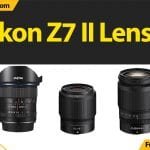
![Best Lenses for Canon EOS M50 Mark II [2021]: Reviews & Buyer’s Guide](https://futureguests.com/wp-content/uploads/2021/01/Canon-EOS-M50-Mark2-Lenses-150x150.jpg)

